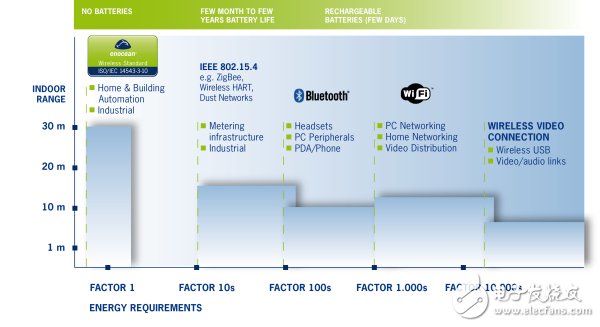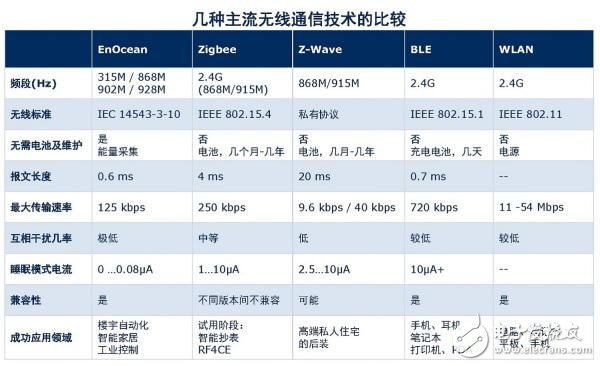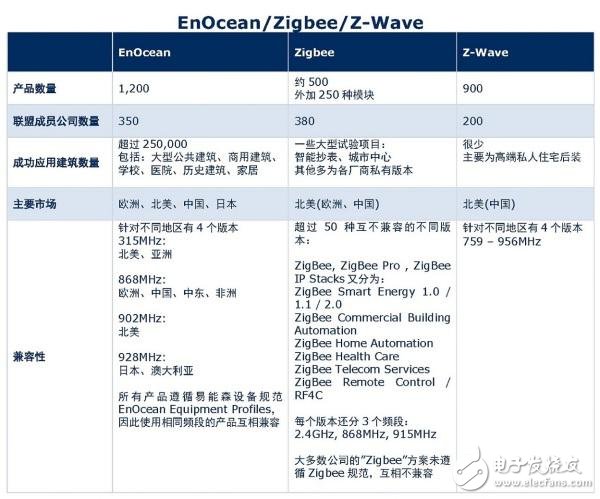In recent years, with the development of home-oriented control and automated short-range wireless technology, the opportunities brought about by home intelligence are becoming a reality. The two advantages of light home compared to traditional smart homes are that they are easy to install and easy to interact with. Among the various short-range wireless communication technologies that have emerged, EnOcean, Zigbee, Z-Wave and Bluetooth are the main means of connecting smart home products.
EnOcean
The EnOcean wireless communication standard was adopted as the international standard "ISO/IEC 14543-3-10", which is the only wireless international standard in the world that uses energy harvesting technology. The EnOcean energy harvesting module captures the energy generated by the surrounding environment and derives weak power from light, heat, electric waves, vibration, and human motion. After being processed, these energies are used to supply EnOcean's ultra-low-power wireless communication modules, enabling true data-free, power-free, battery-free communication systems. The EnOcean wireless standard ISO/IEC 14543-3-10 uses the 868 MHz, 902 MHz, 928 MHz and 315 MHz bands with a transmission distance of 300 meters outdoors and 30 meters indoors.
Zigbee
Zigbee is a low-power personal area network protocol based on the IEEE802.15.4 standard. The technology specified under this protocol is a short-range, low-power wireless communication technology. It is characterized by close proximity, low complexity, self-organization, low power consumption, low data rate, and low cost. It is a cheap, low-power, short-range wireless networking communication technology. Zigbee uses 2.4G, 868MHz and 915MHz. Zigbee's effective transmission range is 10-75m without the use of a power amplifier.
Z-Wave
Z-Wave is a wireless networking specification led by the Danish company Zensys. Z-Wave is an emerging RF-based, low-cost, low-power, high-reliability, network-ready short-range wireless communication technology. The working frequency band is 908.42MHz, and the effective coverage of the 868.42MHz signal is 30m indoors and 100m outdoors, suitable for narrow bandwidth applications. Z-Wave technology is also a low-power and low-cost technology that strongly drives low-rate wireless personal area networks.
Bluetooth
Bluetooth technology is mainly divided into the Wibree standard added in BT3.0+HS and 4.0, which is Bluetooth Low Energy (BLE). In the light home field, we mainly discuss the BLE part. Low-Power Bluetooth (BLE) technology is a low-cost, short-range, interoperable, robust wireless technology that operates in the 2.4G band. BLE uses a variable connection time interval, a few milliseconds to a few seconds. With a fast connection, you can save energy in a "non-connected" state. At this point, the two ends of the link only know each other, and only open the chain when necessary. The road then shuts down the link in the shortest possible time, so it has very low running and standby power consumption.
The difference between EnOcean and the other three protocols
Compared to other technologies in the field, EnOcean technology is characterized by the elimination of batteries. For example, a management system for a 50-60-story high-rise building sometimes uses 4000-6000 sensor units. If each sensor unit uses battery-driven technology, battery replacement and management will be a huge burden, making the building management company at a loss. The weakness of other technologies is the battery-powered device. EnOcean technology guarantees that it will still work when the lighting is off for 5 days. EnOcean technology is designed as a very simple standard. The power required for EnOcean wireless signals is 1/30-1/100 for ZigBee. In addition, since the frequency band below 1 GHz is used, the transmission distance of EnOcean is farther than that of 2.4 GHz Zigbee and BLE, and the interference is less.
Comparison of power consumption and transmission distance of each protocol:

Through the following two tables, we can compare several mainstream wireless communication technologies more intuitively and comprehensively:


Featured by dome surface, 270 wide lighting beam angle, and side bend. S21 covers all colors and functions as well like S15. Comparing with S15, S21 generates more harmonious lighting effect with lower lumen output.S21can be widely used for garden, landscape, stairs, wall grazing, orientation lighting, window reveal and underground.
Black Neon Lights,Flexible Neon,Neon Light Signs For Wall,Led Neon Rope
Tes Lighting Co,.Ltd. , https://www.neonflexlight.com
